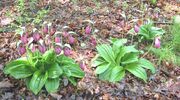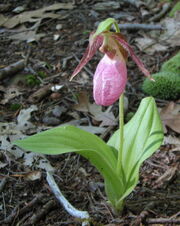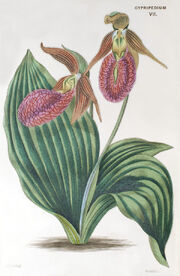| Cypripedium acaule | |||||||||||||||||
|---|---|---|---|---|---|---|---|---|---|---|---|---|---|---|---|---|---|
| |||||||||||||||||
Cypripedium acaule is a member of the orchid genus Cypripedium. Members of this genus are commonly referred to as Lady's Slipper orchids. First described in the 1700s, Cypripedium acaule is commonly referred to as the Pink Lady's Slipper. An alba variety exists which has a white lip instead of a pink one.
In Nova Scotia, Canada it is a protected plant, and it is endangered.
Description[]
Unlike most other members of Cypripedium, the pouch of C. acaule opens in a slit that runs down the front of the labellum rather than a round opening. The plant consists of two plicate leaves near the ground. From between those leaves sprouts a long, pubescent stalk that bears a single pink flower which is 5 cm wide. The sepals and petals tend to be yellowish-brown to maroon with a large pouch that is usually pink, but is sometimes solid white. The plant blooms up to two flowers in late spring.
Distribution[]

Cyp. acaule in the wild
C. acaule can be found in the eastern third of the United States and into Qubec, Ontario, Nova Scotia, New Foundland, Alberta, and New Brunswick, provinces of Canada, coming very close to the arctic circle. This widespread species can be found in a wide variety of environments: from coastal plains to pine barrens to mountain tops. However, it prefers its soil to be highly acidic and can usually be found where pine trees provide a groundcover of needles
C. acaule grows in a variety of different habitats, including moist and dry rich acidic soils. It is usually found in pine forests, where it can be seen in large colonies, but it grows in deciduous woods, and sphagnum bogs as well. It is nearly always found in soil with high acid content. Because of a fungus association needed for growth, and the high acid this plant needs, C. acaule is very difficult to grow in the average garden and is unlikely to survive any attempts at transplantation. Additionally, although this species in common in parts of the northern United States and Canada, it is considered endangered in Illinois and Tennessee and should not be removed or disturbed if found in nature.
Culture[]

Keep humidity from 30 to 70%; it is best kept low. Water with distilled or rain water. Keep the mix slightly moist and allow it to dry. The plant is very drought tolerant and does not usually need to be watered. PH levels should be kept at around 3 to 4.5. Plant will die in a couple of weeks if pH is greater than 5. Individuals have used 1 to 1.5 ounces of vinegar per a gallon of water to maintain pH levels. Keep plant in low nutrient soil. Plant should not be fertilized. Grow in full pine duff.
Plants have been grown in beds created by making a 40cm hole and lining the side with plastic but not the bottom. Then 35 cm would be filled with lime free acidic sand with the pH of 3 to 4.5 and the rhizome of Cyp. acaule would be placed flat on top of the sand and covered with coarse pine humus and then with pine cones and needles above that layer.
USDA zone 3a-8a
Varieties[]
| Image | Name | Description |
|---|---|---|

|
Cypripedium acaule var. alba | Lip is white, sepals and petals are yellow green |

|
Cypripedium acaule variant | Lip is magenta, sepals and petals are dark brown. |
Naming[]

Common Names: Moccasin Flower, The Short Inflorescence Cypripedium, Two-leaved Lady's Slipper
Synonyms[]
- Cypripedium acaule f. biflorum P.M.Br. 1995
- Cypripedium humile Salisb. 1791
- Fissipes acualis (Aiton) Small 1789
Resources[]
![]() Cost of reproduction in the pink lady's slipper orchid (Cypripedium acaule Orchidaceae) an eleven-year experimental study of three populations
Cost of reproduction in the pink lady's slipper orchid (Cypripedium acaule Orchidaceae) an eleven-year experimental study of three populations
